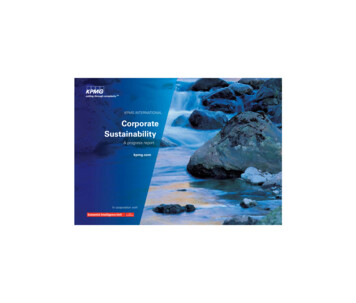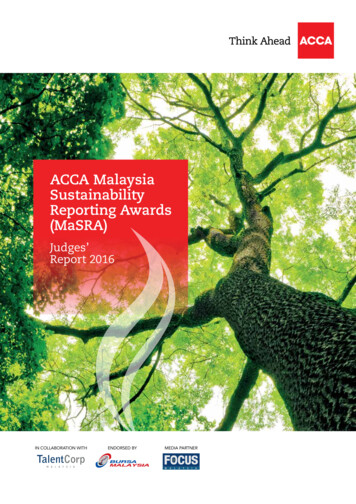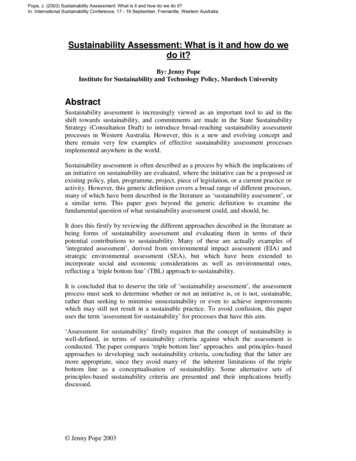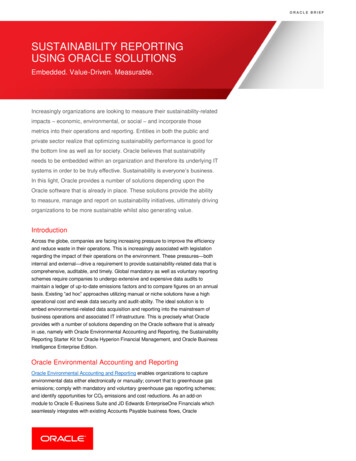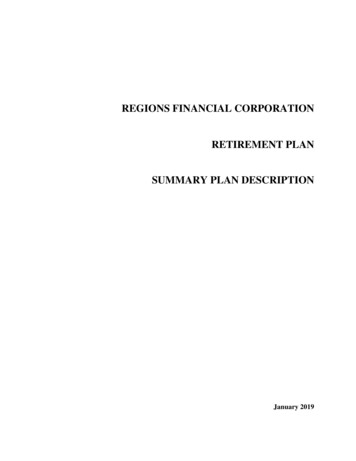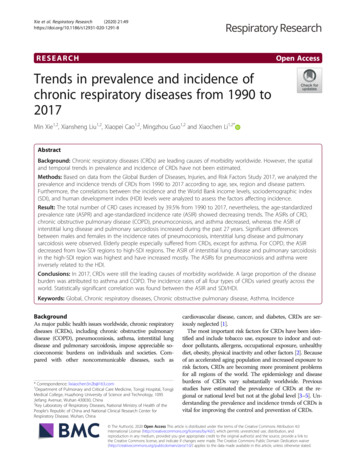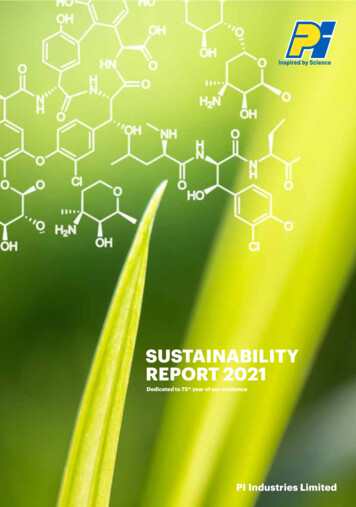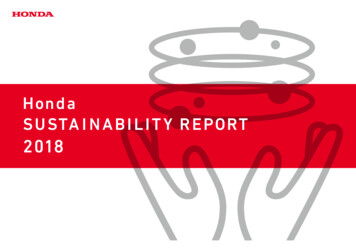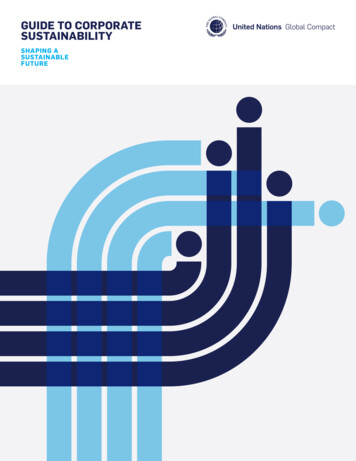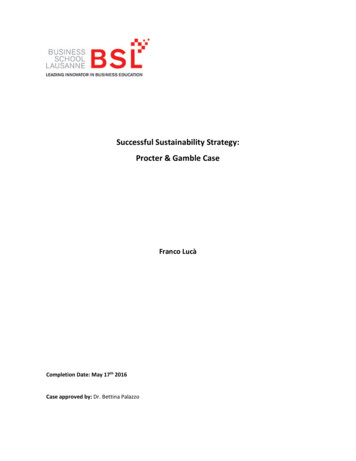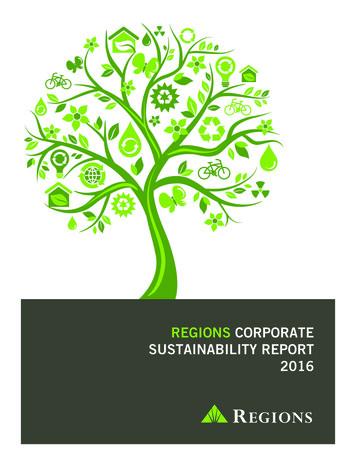
Transcription
REGIONS CORPORATESUSTAINABILITY REPORT2016
SUSTAINABILITY REPORTING GUIDELINESAND PERFORMANCE AREASPageSRG 1.1Letter from the Chairman, President and Chief Executive Officer1SRG 2.1-5, 2.7-8, 2.10 Company ProfileRegions Financial Corporation — Company Profile2SRG 3.1-4 Report Profile3PERFORMANCE AREASEC9 — Indirect Economic Impacts4ENVIRONMENTAL PERFORMANCE INDICATORSEN1 — Materials Used by Weight or Volume7EN2 — Percentage of Materials Used That Are Recycled Input Materials7EN4 — Indirect Energy Consumption by Primary Source9EN5 — Energy Saved Due to Conservation and Efficiency Improvements10EN6 — Initiatives to Provide Energy-Efficient or Renewable Energy-Based Products and Services10EN7 — Initiatives to Reduce Indirect Energy Consumption12EN9 — Water Sources Significantly Affected by Withdrawal12EN22 — Total Weight of Waste by Type and Disposal Method13EN26 — Mitigate Environmental Impacts13EN30 — Total Environmental Protection Expenditures and Investments by Type14LA10 — Training and Education15LA11 — Programs for Skills Management and Life-long Learning15LA13 — Diversity and Equal Opportunity15SO3 — Anti-Corruption Training19
SRG 1.1LETTER FROM THE CHAIRMAN, PRESIDENTAND CHIEF EXECUTIVE OFFICERRegions’ focus on our customers and communities goes far beyond meeting their needs for financial services. Whilewe proudly offer great products and advice with outstanding customer service, we’ve made a broader commitmentto creating shared value for the people, institutions and businesses we serve. We believe it is vital to maintain highstandards as a good neighbor, because it is good for business and because it is the right thing to do.This sustainability report highlights some of the ways our business touches our customers, shareholdersand the communities where we work and live — and helps them secure a brighter future.Regions is committed to preserving our environment, whether through reduced energy use, recycling orencouraging paperless interaction. For example, in 2016: Regions reduced overall solid waste generation by 4 percent over 2015 figures, a difference of over 500tons, and we kept 47 percent of facility-related solid waste from landfills through a combination of buildingrecycling programs and confidential waste recycling. This is a 4 percent increase from 2015 figures. Our Confidential Trash Program collected more than 12.3 million pounds of paper, which saved 104,000trees, 2.3 million gallons of oil, 18,400 cubic yards of landfill space, more than 24.5 million kilowatts ofenergy and more than 43 million gallons of water. Through our Energy Management Program, Regions used 3.7 percent (8 million kWh) less electricity in2016 than in 2015 when comparing the same buildings. This is enough electricity to power over 722average homes for a year. Regions increased our use of solid-state (LED) lighting technology in 2016, to include more interiorand exterior applications. Virtually every exterior lighting project in 2016 included this high-efficiencytechnology. Overall, the systems installed in 2016 use at least 40 percent less energy than the previoussystems, while increasing light levels for our customers. Regions’ energy consumption program has been comparing the same buildings since 2008 and for the11.5 million square feet being tracked, even with rate increases, the cost of electricity for this same groupof buildings was 800,000 less in 2016 than in 2008. Vehicles used to service bank facilities in 2016 used 1,607,710 gallons of gasoline, a 30 percent decreasein sheer consumption as the bank’s facilities fleet dropped from 131 vehicles to 84, and facilities teamsadjusted to even more efficient routing and service frequencies. Regions has a program to reduce water consumption at facilities nationwide and we have targeted irrigationwater use for reduction. Approximately 10 percent of facilities have received either soil moisture sensors orsmart, monitored irrigation controls systems. Through November 2016, 11 million fewer gallons were used in2016 than the same period in 2015.All these efforts help us provide an exceptional experience for our customers and communities. They make alasting, positive impact and are an essential part of being a high-performing financial institution.GRAYSON HALLChairman, President and Chief Executive OfficerRegions Financial Corporation1
SRG 2.1-5, 2.7-8, 2.10 Company ProfileREGIONS FINANCIAL CORPORATION (NYSE:RF)As a company that has been around since 1856, we know that banking relationships are founded on trust. Ourcustomers have the added assurance that our financial strength and stability give them a safe place to keep theirmoney. In addition they have the peace of mind knowing deposits at Regions are FDIC insured.REGIONS IS HEADQUARTERED IN BIRMINGHAM, ALA., WITH 126 BILLION IN ASSETS, IS A MEMBER OF THE S&P 500 INDEX,AND IS ONE OF THE NATION’S LARGEST FULL-SERVICEPROVIDERS OF CONSUMER AND COMMERCIAL BANKING,WEALTH MANAGEMENT, MORTGAGE AND INSURANCEPRODUCTS AND SERVICES. REGIONS SERVESCUSTOMERS ACROSS THE SOUTH, MIDWEST AND TEXAS,AND THROUGH ITS SUBSIDIARY, REGIONS BANK, OPERATES APPROXIMATELY 1,500BANKING OFFICES AND 1,900 ATMS. ADDITIONAL INFORMATION ABOUT REGIONS AND ITSFULL LINE OF PRODUCTS AND SERVICES CAN BE FOUND AT WWW.REGIONS.COM.For the full year 2016, Regions reported net income available to common shareholders of 1.1 billion andended the year with total shareholder return of over 50 percent. We grew net interest income 3 percent versus2015, and we also grew adjusted non-interest income 7 percent. Our adjusted non-interest expenses increasedjust under 2 percent.Regions received recognition across the financial services industry and forservice quality: Regions was the highest scoring bank in the prestigious 2015American Customer Satisfaction Index. Regions won 12 Greenwich Excellence awards in the CommercialBanking Group. Regions won two (of three) inaugural Greenwich Excellence awardsfor Wealth Management.2
For the third year in a row, Regions was recognized by Temkin Groupas a top decile performer in the annual Temkin Retail BankingExperience Rankings. Regions placed 12th out of 294 companiesacross 20 industries. Regions scored an 806 (on a 1000-point scale) in the 2016 J.D.Power Retail Banking Satisfaction Study, placing Regions 3rd out of23 peer banks. Regions has improved from a score of 694 in 2008to 806 in 2016. Regions Bank ranked the Most Reputable Bank in the United Statesin the 2016 Reputation Institute Rankings. Regions was named a winner of the 2016 Gallup Consulting Great Workplace Award.SRG 3.1-4 Report ProfileThe 2016 Sustainability Report includes data from January 1, 2016 – December 31, 2016. SustainabilityReports are issued annually and reports were issued for 2009, 2010, 2011, 2012, 2013, 2014 and 2015.Any questions about this report should be directed to Linda Germany Kramer, Corporate Social Responsibility,linda.kramer@regions.com.3
PERFORMANCE AREASGRI INDICATORSEC9INDIRECT ECONOMIC IMPACTSRegions participated in several economic developmentinitiatives during 2016. In August, Regionsserved as lead sponsor to an Inner CityCapital Connections conference held inSt. Louis, MO., which serves to educatecompanies in or near city centers on how toaccess capital to expand their businesses. Regions also co-chaired the Southeast U.S.-JapanAssociation meeting in Tokyo, Japan, a meeting of business and political leaders fromJapan and seven Southeastern states aimed at building sustainable relationships that leadto economic development.In addition, Regions associates made a positive difference in the communities we servedover the past year: Provided more than 82,450 hours of volunteer work, including 16,667 volunteer hourson financial education. Delivered financial education in classrooms and parent workshops with more than110 trained facilitators, and the Regions at Work team presented more than 87,000financial education seminars during the year throughout the footprint. Reached 16,465 high school students and 17,151 college students through theRegions Financial Scholars Program, powered by EverFi. In addition, the RegionsCollegiate Financial Education Program provided financial education to 2,163student athletes. Completed more than 10,000 volunteerhours with Junior Achievement, earning thePresident’s Silver Award. Provided more than 4,800 hours of technicalassistance to non-profit organizations acrossour footprint.4
GRI INDICATORSEC9, continued Contributed 10.4 million in charitable giving. Donated 25,000 to American Red Cross Disaster Relief Fund to assist inLouisiana Flood Recovery Efforts. Continued the annual “Share the Good” program,which encourages local Regions offices to identifyvolunteer service opportunities to make a positivedifference. Launched “Doing More Today” website to share stories about the communitiesRegions serves and the nonprofit organizations Regions helps. Sponsored the 2016 Riding Forward Scholarship Essay Contest, where studentssubmitted essays about an inspirational African-American of the student’schoosing.Low Income Housing Tax CreditsRegions is one of the nation’s leading direct investorsin Low Income Housing Tax Credit developments.These investments provide cash equity vital to theconstruction and rehabilitation of affordable housingunits for low- and moderate-income renters. In 2016,Regions invested more than 283.9 million in suchtax-credit partnerships, supporting 50 developments that provide4,393 units of affordable housing for low- and moderate-income individuals and families instates where Regions conducts business.THIS ACTIVITY IN 2016 BRINGS TO 25,164 THE TOTAL NUMBER OF AFFORDABLEHOUSING UNITS REGIONS IS SUPPORTING THROUGH ITS INVESTMENTS DATINGBACK 15 YEARS (THE LIFESPAN OF THESE TAX CREDITS). REGIONS’ AFFORDABLEHOUSING INVESTMENTS HELP MAKE A DIFFERENCE IN THE COMMUNITIES THE BANKSERVES BY IMPROVING THE LIVES OF LOW- AND MODERATE-INCOME INDIVIDUALSAND FAMILIES.5
GRI INDICATORSEC9, continuedVolunteer HoursIn 2016, Regions associates volunteered at more than 8,000 different agencies in thecommunities where they live and work and provided more than 16,500 volunteer hoursteaching financial education. To make it easy to volunteer, associates receive one day offper year with pay to volunteer through What A Difference A Day Makes, Regions’ volunteerprogram. They may serve a 501(c)(3) non-profit organization that supports one of thefollowing categories: Arts/Culture Community Development Economic Development Health/Human Services Education Regions-sponsored Charitable EventsThe Regions Matching Gifts Program allows associates to make an even greaterdifference to education institutions and arts and culture charities by doubling their taxdeductible contribution of at least 25 and up to 1,000 per calendar year. In 2016,Regions matched 244,000 in associate contributions.Supplier DiversityIt’s clear to Regions that many minority- and women-owned enterprises offer the quality,innovation, reliability and value we seek. We regard these strategic relationships as goodfor society, good for business and good for strengthening our competitive advantage. Ourbusiness relationships with diverse suppliers make a positive impact on the communitieswe serve by creating jobs and wealth. Expense reduction initiatives across the companyin 2016 resulted in reduced diversity spend and 14 percent fewer vendors. However, theoverall supplier diversity spend remained at 7.3 percent of total spend, the same as in 2015.6
ENVIRONMENTALPERFORMANCE INDICATORSGRI INDICATORSEN1MATERIALS USED BY WEIGHT OR VOLUMERegions Financial Corporation does not calculate the total weight or volume of materialsused in daily operations, in construction, in maintenance, or in service to customers.Regions utilizes a decentralized purchasing system. While many materials are purchasedthrough channels that can be used to track weight or volume, some materials are not.Regions is not set up to measure the weight or volume of the enormous variety of materialsused in daily operations (from construction materials and furniture, to printer cartridges,marketing materials and pencils). Any attempt to record this information for 2016 would beincomplete and potentially misleading.EN2PERCENTAGE OF MATERIALS USED THAT ARE RECYCLED INPUT MATERIALSRegions Corporate Real Estate uses recycled-content carpets, ceiling tiles and drywall inongoing projects whenever feasible. However, calculating a percentage of the total requiresunderstanding the total volume or weight of materials purchased (as per G4-EN1, above),which is not available for 2016.Regions has been purchasing remanufactured toner cartridges for standard officeprinters for several years. In 2016, Regions purchased 25,000 remanufactured tonercartridges for office use. Each remanufactured toner cartridge is made from the plastic shellof a previously used cartridge, reducing the environmental impact of the manufacturingprocess. Cartridges are made of virgin plastic — a petroleum product — and when buriedin a landfill without access to UV rays, these cartridges do not decompose. Thus, theremanufactured cartridges: Saved approximately 7,200 gallons of fuel Reduced 234 cubic yards of waste in landfills – when toner cartridges are buriedin a landfill without access to UV rays, these cartridges either do not decompose,or if they do, the time this would take is thousands of years.7
GRI INDICATORSEN2, continuedRegions Confidential Waste Program is the most widespread recycling program at thebank. In 2016, the program collected 12,316,076 pounds of paper and other confidentialmaterial. According to our vendor contract, this paper was shredded to protect theconfidentiality of the information.The shredded paper was then used by mills located in the U.S. in the manufacturingof new paper, thereby, providing the following benefits to the environment: Saved 104,487 trees Saved 2,335,581 gallons of oil Reduced 18,439 cubic yards of landfill space Saved 24,585,061 kilowatts of energy Saved 43,023,857 gallons of water Saved 368,776 pounds of air pollutionTo drive down the use of paper, Regions continues to move more work to digitaldocuments and increase the use of duplex (double-sided) printing. Associates are alsotrained in paperwork reduction. These programs are ongoing.In 2016, Regions reduced overall solid waste generation by 4 percent over 2015 figures,a difference of over 500 tons. this is approximately the amount of trash generated by 685people in a year. (“Advancing Sustainable Materials Management: 2014 Fact Sheet”; U.S.Environmental Protection Agency, November 2016.) In addition to the reduction in totalwaste, Regions increased our diversion percentage. This year, we kept 47 percent of facilityrelated solid waste from landfills through a combination of building recycling programs andconfidential waste recycling. This a 4 percent increase from last year’s figure. Regionscontinues to encourage the use of electronic account statements.For those customers receiving paper statements, Regions uses soy-based inks andeco-friendly material for window film for statement envelopes (approximately 40 millionannually). The use of these two items allows these envelopes to be recycled. Recycledpaper is used in various marketing materials including direct marketing, collateral brochuresand in-branch advertising.Regions redeployed 3,135 pieces of information technology (IT) hardware internally in2016, eliminating the need to purchase new hardware. Regions disposed/recycled some2,132 pieces of IT hardware, and 7,782 pieces of IT hardware were re-sold.8
GRI INDICATORSEN4INDIRECT ENERGY CONSUMPTION BY PRIMARY SOURCEWith few exceptions, Regions does not burn primary energy sources such as coal or naturalgas to generate electricity, steam, or other energy for consumption. Exceptions are the useof petroleum products to run vehicles and emergency generators, and the use of naturalgas in boilers and furnaces. For boiler operations, Regions purchased 47,000 gallons ofdiesel fuel to test and operate emergency generators and other equipment in Birminghamand Nashville. This is higher than 2015 but still 27 percent less than in 2013.Vehicles used to service bank facilities in 2016 used 1,607,710 gallons of gasoline, a30 percent decrease in sheer consumption as the bank’s facilities fleet dropped from 131vehicles to 84, and facilities teams adjusted to even more efficient routing and servicefrequencies. Most of the vehicles remaining in the fleet are vans for maintenance techniciansand, for a few months, several technicians were covering extended territories. Vans are thenecessary but least-efficient vehicles in the fleet, meaning the average fuel economy declinedslightly, to 12 miles per gallon versus 13 mpg last year. The changes from 2015 to 2016required fewer overall gallons purchased but negatively impacted overall fleet fuel economy.To operate the employee shuttle service at a Birmingham office complex, Regionsprocured 6,300 gallons of propane between October 2015 and October 2016. This shuttlehas been operating as a propane-fueled vehicle since mid-2013. The use of propaneinstead of gasoline has reduced local emissions significantly. Propane burns cleaner andproduces less carbon monoxide (by 60 percent), carbon dioxide (by 12 percent) andcarcinogenic emissions (by more than 90 percent), generally creating better air quality forassociates riding the vehicle or walking nearby.Regions operates properties that consume energy (primarily electricity) generated fromsources that vary from location to location, and region to region. In most states where Regionsoperates, electricity primarily is generated from fossil fuels (coal and natural gas). However,Regions owns and operates buildings in areas fueled by hydro-power and nuclear energy.REGIONS CONTINUES TO PURCHASE 5,000 KWH PER MONTH OF RENEWABLEENERGY THROUGH DUKE ENERGY’S GOGREEN INDIANA INITIATIVE. THE ENERGY FORTHIS PARTICULAR PROGRAM IS GENERATED FROM REGIONAL WIND SOURCES.9
GRI INDICATORSEN4, continued During 2016, Regions associates’ participationin CommuteSmart reduced vehicle miles traveled by554,410, which reduced pollution by approximately277 tons and carbon dioxide emissions by 306,588,730 grams and saved approximately22,000 gallons of fuel.EN5ENERGY SAVED DUE TO CONSERVATION AND EFFICIENCY IMPROVEMENTSRegions has focused on energy conservation and efficiency since 2008 and continues tofocus on reducing energy consumption across the country. Through our Energy ManagementProgram, Regions used 3.7 percent (8 million kWh) less electricity in 2016 than in 2015when comparing the same buildings. This is enough electricity to power over 722 averagehomes for a year (per U.S. Department of Energy Residential Energy Consumption Survey,2014). To measure progress, Regions’ energy consumption program has been charting thesame buildlings since 2008. For the 11.5 million square feet being tracked, even with rateincreases, the cost of electricity for this same group of buildings was 800,000 less in 2016than in 2008.EN6INITIATIVE TO PROVIDE ENERGY-EFFICIENT ORRENEWABLE ENERGY-BASED PRODUCTS AND SERVICESRegions does not provide energy-based products or services for bank customers. However,the energy required to operate the buildings that serve our customers is steadily decreasing.Furthermore, customers are provided with the option of banking electronically, which avoidsthe need for paper to be fabricated and shipped, avoids the printing and mailing of statements,and reduces the number of vehicle trips to a branch for transactions. Regions encouragesthe use of electronic account statements. For those customers receiving paper statements,Regions uses soy-based inks and material for window film for statement envelopes(approximately 40 million annually).Recycled paper is used in various marketing materials including direct marketing,collateral brochures and in-branch advertising, and materials have been redesigned toincrease efficiency and use less ink in the printing process. Examples of Regions’ efforts toprovide energy efficiency to customers include financial products offering environmentallyresponsible services (e.g., paperless statements, direct deposit, electronic receipts), as wellas building improvements.10
GRI INDICATORSEN6, continuedAdditional information about these efforts includes:LifeGreen CheckingRegions LifeGreen Checking and Savings accounts provide the bank’s most requested andmost environmentally friendly products and e-services including: Recycled checks Regions Online Banking with Bill Pay Regions Mobile Banking Direct deposit Online Statements Regions CheckCardIn addition, Regions offers the LifeGreen eAccess Account designed for customers whoprefer to bank or make purchases online rather than by check with electronic features likeOnline Banking with Bill Pay, Mobile Banking, debit or credit cards.In 2016, Corporate Marketing continues to focus on the importance of recycled materialsfor use in printed pieces. Recycled paper is used in various programs including directmarketing, collateral brochures and in-branch advertising. For merchandising programs,hundreds of mature trees were saved through the use of recycled paper. The paper waspurchased exclusively from domestic sources which participate in the planned replanting oftrees. For each tree harvested, at least two were planted and in many cases the ratio is 3:1.Mobile BankingRegions Mobile Banking encourages efficientmoney management and paperless transactionsby offering customers: Convenient and secure access to theirRegions accounts from their mobiledevice Bill payment capability Funds transfer capability Mobile Deposit – allows consumer and business customers to take a picture ofa check and send to the bank for deposit electronically allowing them to avoida trip to the branch11
GRI INDICATORSEN6, continuedRemote Item CaptureRegions Quick Deposit provides business customers a scanner they can use to make depositsremotely from their offices, whenever they want. This saves time and provides an energyefficient means of depositing checks.Regions Online PayrollRegions Online Payroll helps small business owners manage their payroll efficiently and ontime. Environmentally friendly features include direct deposit and the ability to pay taxesand file forms electronically.E-ReceiptsRegions customers have the option to receive transaction receipts electronically.ATM ReceiptsATM receipts are printed on paper that is BPA-free.EN7INITIATIVES TO REDUCE INDIRECT ENERGY CONSUMPTIONRegions has made extensive use of motion-sensingequipment to turn lights off, or partially off, whenareas are unoccupied. This technology is being usedsuccessfully in both interior and exterior applications.Regions increased our use of solid-state (LED) lightingtechnology in 2016, to include more interior andexterior applications. Virtually every exterior lightingproject in 2016 included this high-efficiency technologyin at least one aspect. Additionally, LED lightingtechnology was increasingly used in interior applications. Overall, the systems installed in2016 use at least 40 percent less energy than the previous systems, while increasing lightlevels for our customers.EN9WATER SOURCES SIGNIFICANTLY AFFECTED BY WITHDRAWALAlthough Regions has an extensive footprint in 15 states, banking is not a water-intensiveindustry and Regions does not withdraw a significant percentage of water from any single12
GRI INDICATORSEN9, continuedwatershed. However, Regions recognizes water is a critical issue, and has dedicatedresources to reduce domestic use and irrigation demands. A large percentage of ourwater use goes to irrigation, and we have targeted irrigation water use for reduction.Approximately 10 percent of facilities have received either soil moisture sensors orsmart, monitored irrigation controls systems. Through November 2016 (latest figuresavailable), we can report 11,000,000 fewer gallons were used in 2016 than the sameperiod in 2015.Janitorial vendor services cleaning Regions Bank Facilities do so with environmentally-preferable cleaning practices that include less need for water, further reducing the needfor water during normal operations.EN22TOTAL WEIGHT OF WASTE BY TYPE AND DISPOSAL METHODIn 2016, approximately 7 percent of non-confidential waste from Regions’ facilitieswas diverted from the landfill, a percentage point improvement from last year. The bankcaptures most paper through a confidential shredding program, and in 2016 more than12.3 million pounds of confidential material (mostly paper) were collected and recycled.In addition to the confidential paper shredding program, we estimate at least thefollowing quantities were diverted from landfills and recycled in 2016 through workplacerecycling programs: Plastic: 39,000 pounds Aluminum: 18,000 pounds Corrugated Cardboard and Paper: 199,000 poundsEN26MITIGATE ENVIRONMENTAL IMPACTSIn 2016, Regions Bank expanded the use of environmentally sound cleaning practicesto virtually every facility in the country. These practices include waterless cleaning usingspecial mops, more organically-based cleaners and reusable cleaning materials. Since2010, Regions has employed a portfolio-wide program to manage fluorescent lampsresponsibly.13
GRI INDICATORSEN26, continuedITEMS COMMONLY RECYCLED IN REGIONS’OFFICE RECYCLING PROGRAM INCLUDEALUMINUM CANS, CORRUGATEDCARDBOARD, NEWSPAPER ANDPLASTIC BOTTLES.In 2016, Regions continued providing associates with a convenient and environmentallyappropriate method of disposing personal electronics. The company held ElectronicsRecycling Events at three large campuses. Over 100 associates recycled more than 1,500pounds of personal devices at these events. The crews collected old computers, gamesystems, cell phones, televisions, and even a rotary-dial phone. All this material wasdiverted from landfills and safely recycled. The vendor utilized for this service is certifiedto the Responsible Recycling (R2) Standard by Sustainable Electronics RecyclingInternational, meaning they have passed rigorous reporting and oversight requirements toprove their disposal practices are environmentally and ethically sound.EN30TOTAL ENVIRONMENTAL PROTECTION EXPENDITURESAND INVESTMENTS BY TYPERegions has developed and currently implements a thorough and protective environmentalcompliance program, developed to protect the safety of associates and customers. Aspart of the Asbestos Management Program, all Regions’ facilities management and projectmanagement personnel received training on how to identify and manage asbestos properly.Vendors are alerted to the presence of asbestos beforeentering such a facility, and Regions utilized certifiedasbestos abatement contractors to remove asbestos aspart of projects in over 100 locations in 2016. RegionsCorporate Real Estate also manages all facilities with anaggressive and protective environmental program thatassures indoor environmental quality.14
GRI INDICATORSLA10TRAINING AND EDUCATIONRegions associates completed 295,297 hours of mandatory annual Compliance Trainingin 2016. This includes seven Core Compliance Training courses every associate isrequired to complete each year. Core curriculum course topics include Bank Secrecy Act/Anti-Money Laundering, Consumer Privacy, Business Ethics and Fair and Consistent Treatment,Information Security, Fair and Responsible Banking, Fundamentals of Risk Management,and business unit procedures for Bank Secrecy Act/Anti-Money Laundering. Regionsassociates also completed 5,250 hours of continuing education training relating to moneylaundering and fraud prevention, including elder financial exploitation.LA11PROGRAMS FOR SKILLS MANAGEMENTAND LIFE-LONG LEARNINGAll associates are eligible for the Regions undergraduatetuition reimbursement program, which provides upto 5,000 each year in reimbursement for businessrelated undergraduate degree programs. During2016, 176 associates participated in Regions’ TuitionReimbursement Program and were reimbursed 427,246.LA13DIVERSITY AND EQUAL OPPORTUNITYAt Regions, diversity goes beyond race and gender to encompass age, ethnicity, veteran status,disability, sexual orientation, gender identity, religious beliefs, marital status, and manyother dimensions that make each of us unique as individuals. Our strategic approach todiversity supports overall business priorities and fosters an environment that values allindividuals for the skills and talents they bring to the company. Diversity efforts aresupported by senior leaders and associates, and the effectiveness of the company’sdiversity efforts is measured through the Corporate Diversity Index (CDI). The CDI is aninternal management tool used to measure, analyze and assess diversity performanceat Regions. It is produced semi-annually. Examples of Regions’ diversity initiatives andactivities include:15
GRI INDICATORSLA13, continuedRegions Diversity Advisory CouncilThe Regions external Diversity Advisory Council is composed of various academic, communityand business leaders and provides an objective outside perspective and offers guidance ondiversity-related matters. Specifically, the Diversity Advisory Council supports the company by: Offering advice, counsel and feedback regarding the strategic direction of thebank’s existing diversity and inclusion initiatives and programs Providing executive recruitment input as the organization continues to developa diverse talent pipeline and associate base Enhancing Regions’ brand by participating in targeted marketing efforts anddiversity-focused business developmentRegions Diversity NetworkThe Regions Diversity Network is an association of leaders who work together to advancethe company’s comprehensive diversity and inclusion strategy. The network — composedof associates who work in areas and on matters that
Regions scored an 806 (on a 1000-point scale) in the 2016 J.D. Power Retail Banking Satisfaction Study, placing Regions 3rd out of 23 peer banks. Regions has improved from a score of 694 in 2008 to 806 in 2016. Regions Bank ranked the Most Reputable Bank in the United States in the 2016 Reputation Institute Rankings.
